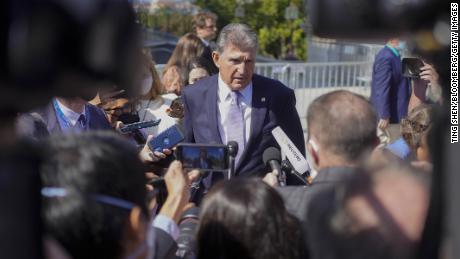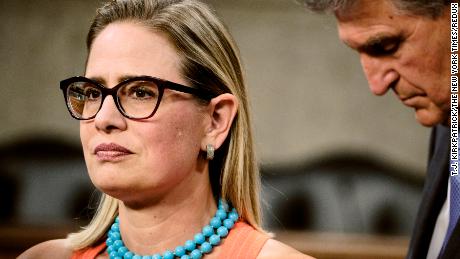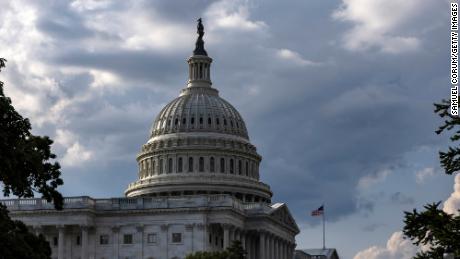(CNN)Anger is peaking among a wide range of Democrats toward Sens. Joe Manchin and Kyrsten Sinema over their resistance to President Joe Biden's economic agenda, but the Democrats' struggle to pass Biden's sweeping plan is rooted in more than the personal idiosyncrasies and electoral calculations of two individual senators.
It also illustrates the structural challenge of passing big legislation through a Senate that is more closely and deeply divided than in earlier generations.
Compared with most of the 20th century, it has become much more rare since 2000 for either party to accumulate a comfortable Senate majority of 55 seats or more. And yet, even as each party is operating with fewer Senate votes of its own, it has also become more difficult for the majority to win votes from senators in the opposition party for its key initiatives.
These two trends have produced a political environment in which the only plausible path for presidents to pass their major priorities is to achieve near- (or even complete) unity in their party.
As Manchin and Sinema have demonstrated over the past week, that creates enormous leverage for even a tiny handful of senators to block their party's program -- a point Biden acknowledged with obvious frustration at his news conference Monday. Something similar happened to Senate Republicans during President Donald Trump's first year, when dissent from just three GOP senators doomed a broadly supported effort in the party to repeal the Affordable Care Act.
In the years ahead, the turmoil evident in the Senate over Biden's agenda may become more the rule than the exception, as both parties operate with extraordinarily little margin for error -- and even the slightest cracks in the unity of the majority are magnified by the ferocity of lockstep opposition from the minority.
Under these pressures, the Senate is simultaneously growing more polarized and more paralyzed. That dynamic has frustrated both sides, but it likely constitutes a greater long-term threat to Democrats, both because they typically try to pass more legislation than Republicans, but also because the core trend driving the polarization -- the increasing alignment of presidential and Senate outcomes in the states -- tends to magnify Republican influence in the chamber.
The Democrats' current Senate majority is the most precarious possible: just 50 senators plus Vice President Kamala Harris as a tiebreaking vote. Such slim Senate majorities have become much more routine in this century than in the past.
Shrinking margins
Since 2001, either party has reached 55 Senate seats only three times: Republicans immediately after President George W. Bush's reelection in 2004, and Democrats immediately after President Barack Obama's wins in 2008 and 2012. (The 2009 Democratic-led Senate, with 59 seats immediately after the election, was the only one since 2001 to exceed 55 seats.)
By contrast, Democrats reached 55 or more Senate seats in every Senate from 1961 through 1980 but one (the only exception came in 1971); in fact, in six of those 10 Senates, Democrats held at least 61 seats.
The elevated margins Democrats enjoyed in the body from the 1960s until 1980 were undermined when the party lost its hold on virtually all of the Southern Senate seats in the region's post-civil-rights realignment. But even after that advantage vanished, one side or the other still reached the 55-seat threshold seven times from 1981 through 2000. (Democrats did it four times, and Republicans three.) That reflected a more fluid political environment in which enough states could still swing between the parties to allow either side to accumulate a substantial Senate advantage when the national political current shifted in its direction.
That's much less true today. Fewer seats seem genuinely at play because of the tightening relationship between the results in presidential and Senate contests. It has become increasingly difficult for candidates in either party to win Senate seats in states that usually vote the other way for president.
In 2016, for the first time ever, every Senate race went the same way as the presidential contest in that same state; in 2020, the same thing happened, except in Maine, where Republican Sen. Susan Collins won in a state that Biden comfortably carried. If anything, 2020 surpassed 2016 in underscoring the link between presidential and Senate outcomes: Democrats poured unprecedented sums of money into Senate challenges in North Carolina, Iowa, South Carolina, Montana and Kansas, among other states, but when Biden failed to carry any of them, their Senate candidates failed too. The Senate seats Democrats did gain in 2020 came in states that Biden also won: Arizona and Georgia.
After that stark outcome, Democrats now hold 47 of the 50 Senate seats in the 25 states that voted for Biden; Republicans, in mirror image, hold 47 of the 50 Senate seats in the 25 states that voted for Trump. Pulling back the lens only sharpens the picture. In the six presidential elections since 2000, 26 states have voted Republican a majority of the time: The GOP now holds 45 of their 52 Senate seats. Over that same period, 23 states have voted mostly for Democrats: The party now holds 43 of their 46 Senate seats. Iowa, the final state, has split 3-3 in presidential races since then (while shifting sharply toward the GOP in the past two): Republicans hold both of its Senate seats.
This hardening underlying dynamic makes it difficult for either party to amass a comfortable Senate majority. Since "the Senate outcomes now line up with the presidential outcomes" and about half the states lean toward each party in presidential contests, "you get a pretty even balance in the Senate in the same way," says Gary C. Jacobson, a University of California at San Diego political scientist who specializes in Congress. "So it's hard to break out of that parity because there have not been a lot of Senate candidates who have shown the ability to win across party lines."
Few 'split ticket' voters
The same correlation of presidential and Senate outcomes that makes it more likely that each party can scratch out only a narrow Senate majority also makes it less likely the majority party can attract enough support from the minority to reach the 60 votes required to break a filibuster.
One implication of this alignment is that the vast majority of senators are sent to Washington by voters who also supported presidential candidates from their same parties. That creates enormous electoral pressure on Democratic senators to vote with a Democratic president and against a Republican one, and vice versa for GOP senators. The pressure is especially acute in this modern era, when any president faces overwhelmingly negative job approval ratings from voters on the other side.
The force of that "negative partisanship," says Thomas E. Mann, a senior fellow in governance studies at the Brookings Institution and longtime student of Congress, makes it almost impossible for senators to support initiatives from a president of the other party. "Even when you take policy arenas where you can imagine [bipartisan] cooperation happening in a lab, place it in our current system or structure of politics and it can't happen," he says. "Most of the ties to parties are negative ties against the other party -- and that's especially felt keenly on the Republican side, but it's growing on the Democratic side."
Manchin, a West Virginia Democrat, is in some ways a throwback to the earlier era when more senators (and House members) represented "split ticket" constituencies that usually vote for the other party's presidential nominees (Trump won West Virginia by almost 40 percentage points in 2020). From the 1970s through the 1990s, those senators -- southern Democrats like John Breaux or Sam Nunn, coastal Republicans like Bob Packwood or Jacob Javits -- were often the Senate's most enthusiastic deal-makers, largely because they recognized it was in their interests to tamp down partisan hostilities. Sinema of Arizona, a Democrat representing a state that had supported Republicans for president almost entirely from 1952 through 2016, seems to envision a similar role.
But, in fact, the maneuvering of Manchin and Sinema in the current budget fight actually shows how much Congress has changed since that earlier era -- and why the role they are claiming is so diminished. In their heyday, the "split ticket" legislators of the earlier era represented a large enough share of the Senate to build meaningful bipartisan coalitions on a regular basis.
"I used to have a coalition of about 10 people from both sides of the aisle that we could work with," Breaux told me. "They don't have that anymore -- on both sides. The moderates are in the minority on both sides of the aisle, and that's why you are seeing the [conflict] we are seeing right now."
Bigger problem for Democrats
Sinema and Manchin were able to help forge the bipartisan infrastructure deal. But that agreement, on an inherently less ideological issue, looks very much like the exception. Neither senator is suggesting that any changes they are proposing to the reconciliation bill would convince any Republicans to vote for it. No Republican senator has publicly endorsed the voting rights legislation that Manchin renegotiated with his Democratic colleagues; several of his most obvious targets, to the contrary, have already signaled their opposition. Nor did enough Republicans heed his plea to support an independent commission to investigate the January 6 attack on the Capitol. Democrats likewise have been unable to attract 10 Republicans on other potential areas of agreement, including gun control, a pathway to citizenship for young undocumented immigrants and police reform.
That leaves Manchin and Sinema in a very different situation from the earlier deal-makers like Breaux or Nunn. That older generation could, at times, advance a positive agenda that built a majority coalition across party lines; the influence wielded by Manchin and Sinema is now almost entirely negative. They can block their own party's ideas, but on virtually all issues they can't create the bipartisan alternative they claim to seek.
"There is no one to deal with on the Republican side of the aisle; it just can't be done now," says Mann. "So all Manchin and Sinema can do is negative," by forcing Democrats to scale back their plans.
Jacobson notes that the narrow Senate majorities discourage compromise in another respect: Because the minority party is now almost always close enough that it can envision regaining control in the next election, it has even less incentive to cooperate in legislative achievements that could buttress the majority. When "control is at stake in every election," he says, "that makes for intransigence, posturing and inability to compromise."
Both parties have been affected by a Senate that is closely and deeply divided. Every Republican did vote together to pass Trump's tax cuts in 2017 (over the opposition of every Democrat) while the GOP held only 51 Senate seats. But a revolt that same year from just three Republican senators, combined with resistance again from every Democrat, blocked the GOP from repealing the Affordable Care Act, though the vast majority of Republicans in both chambers supported the repeal.
But on balance these new patterns probably present a greater challenge to Democrats, for several reasons.
One is that they have a much broader legislative agenda than Republicans, whose priorities are centered on two goals -- cutting taxes and appointing federal judges and Supreme Court justices -- that under existing Senate rules can already be passed with simple majority votes. (Taxes can be cut through the reconciliation process and judicial appointments are exempt from the filibuster.) As long as the filibuster remains in place, a bigger share of the Democratic legislative wish list -- everything from immigration to gun control and voting rights -- requires 60 votes.
Representing a more diverse electoral coalition, Democrats are also dealing with a broader ideological range among their senators than the GOP. While moderates constitute a very small share of the GOP caucus compared with conservatives, left and center are more closely divided on the Democratic side -- a dynamic Manchin pointedly underscored last week when he told those advocating for a larger reconciliation package to simply "elect more liberals."
But that's easier said than done. The final problem for Democrats is that the ceiling for the number of Senate seats they can win under normal circumstances -- with centrist or liberal candidates -- is probably slightly lower than for Republicans. Even though Democrats have won the popular vote in five of the six presidential elections since 2000, Republicans, as noted, have won slightly more states a majority of the time during that period -- which gives them a small but significant edge in the battle for Senate control.
Moreover, in 2022, Republicans can reasonably expect to competitively challenge Democratic incumbents in at least four Biden states from 2020: Arizona, Georgia, Nevada and New Hampshire. In Trump states holding Senate elections, Democrats are likely to be competitive in the North Carolina open seat and might be able to contest Ohio and Florida -- but their best chance for gains is further consolidating their grip on the Biden states by winning seats the GOP now holds in Wisconsin and Pennsylvania.
The filibuster debate
To many observers, those limited opportunities underscore the need for Democrats to improve their competitive positive in at least a few more states. It's telling that the Senate seats they flipped in 2020 came not in states they had bombarded with late television advertising, but in Arizona and Georgia -- states where they had invested for years in grassroots organizing that also lifted Biden to victory. North Carolina is a plausible next target for Democrats to add a Senate seat in 2022 with that strategy, but after that the options, particularly Florida and Texas in the Sun Belt or Ohio and Iowa in the Rust Belt, look more daunting.
The other implication of these dynamics for Democrats is the increasing pressure in the party to end the filibuster so that they can govern during the periods when they squeeze out a narrow Senate majority.
"There's no real room to build coalitions that give really any chance of overcoming a routine requirement of 60 votes to get anything done," notes Mann.
Even Breaux, a centrist who built his Senate career on finding deals with Republicans, thinks Democrats need to end the filibuster for what he calls "constitutional issues" such as voting and abortion rights. The filibuster, he says, can encourage cooperation "when you have an aggressive middle on both sides, and you don't have that now." As a result, he believes "in getting rid of [the filibuster] for constitutional issues, like voting rights. We've done it for the Supreme Court and federal judges, so I guess you could do a limited carve-out for constitutional issues. That at least would help get some things done."
One final ingredient makes the operation of the modern Senate even more combustible. Because Republicans now so thoroughly dominate the less-populated, heavily rural, predominantly White states across the Plains and Mountain West, the GOP can exercise enormous power in the Senate even while representing many fewer people than Democrats do. If you assign half of each state's population to each senator, Democrats now represent 56% of the country and Republicans 44% -- even though each side holds 50 Senate seats.
As population continues to concentrate in the largest states, this partisan imbalance will likely widen. Without a change in the filibuster, that would allow states representing an ever-shrinking share of the national population to block legislative action supported by senators representing a clear majority of the country.
"The dynamic is that a smaller and smaller segment of the American electorate will control more and more seats in the Senate," says Mann. "So that there will be, in my view, a distortion that is so great it puts into question the entire legitimacy of the Senate as a governing body."
CORRECTION: An earlier version of this story gave the wrong election year in a discussion of upcoming Senate races. They will take place in 2022.























